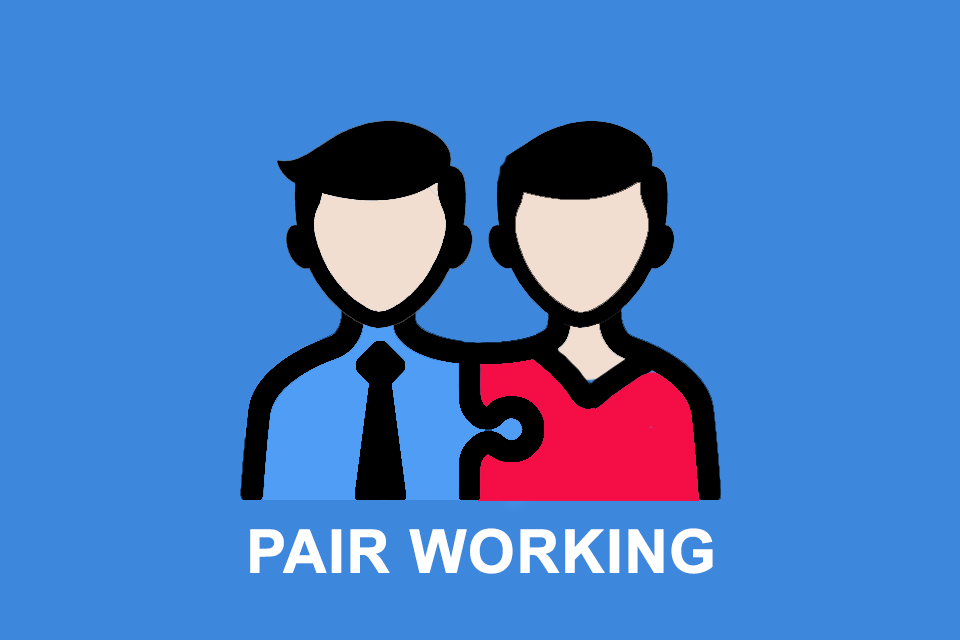What is Pair Working?
Smartpedia: Pair working refers to the cooperation of two people who want to master a qualitative task or achieve a goal as a tandem.
Pair Working – mastering challenges as a tandem with additional skills
In mathematics, 1 + 1 = 2, but in the world of work the result can be greater than two. Pair Working refers to two people working together as a tandem to overcome qualitative challenges and achieve common goals. Pair Working is still a relatively new term, but in the context of companies, organisations are increasingly taking a liking to the concept.
- Different perspectives,
- experiences,
- skills,
- knowledge and
- networks of a pair of colleagues,
complement each other and provide for “better” solutions, both in comparison with the singular performance of an individual and with the added performance of two individuals.
Examples of Pair Working
Pair Working is suitable everywhere where qualitative activities are carried out and complex tasks are mastered, or where interaction with many people takes place. Below you will find some examples:
Pair Consulting: In consulting, two consultants work together as a team to advise, guide and support a client. The two consultants work together to address the client’s needs and combine their skills to identify an effective solution.
Pair Coaching: In agile coaching or leadership development, two coaches work together as a pair to support a team or organisation in their work. The pair brings different perspectives, experiences and skills to the coaching relationship and can provide a more comprehensive approach to coaching.
Pair Training: In a training or workshop, two coaches work together to deliver content and facilitate activities. This approach allows for more dynamic and engaging training sessions as trainers can switch roles and provide different perspectives and insights to participants.
Pair Programming: In pair programming, two programmers with different roles develop together on one computer: one of them writes the code, taking the role of driver or pilot. The other thinks about the problem and the solution, checks the written code and addresses things that come to his or her attention. He thus takes on the role of navigator or observer. This form of Pair Working is probably the most widespread, as it often enables more efficient and effective code development, early feedback, quick identification of errors or rapid problem solving.
Pair Designing: In the field of user experience (UX) design, two designers work together to find a solution to a problem or challenge. The pair can bring different design skills, styles and ideas to the process, resulting in a more creative and effective design solution.
Pair Researching: In academic or scientific research, two researchers work together to conduct investigations, analyse data and draw conclusions. This approach can lead to more thorough research as the pair can challenge each other’s assumptions and biases and bring different perspectives to the research problem.
Pair Writing: Pair writing is a collaborative writing technique in which two people work together to produce a text. In this process, they sit down together, either in person or remotely, and share the responsibility of writing the text.
Advantages and disadvantages of Pair Working
Pair Working offers several advantages:
- Organisations benefit from more than one perspective and from different coaching and communication styles.
- They benefit from a broader knowledge and experience base and access to a wider network.
- Depending on the situation, they benefit from a division of roles within the pair; for example, there could be an active coach and an observer in the room. Step by step, this increases their understanding of the existing system.
- And ideally – in the course of pair programming or pair writing – they receive high-quality software or texts.
In Pair Working there are also some points that can be seen as challenges or disadvantages:
- Often there is additional work involved in finding a second coach or trainer. Here it is advisable to either look for appropriate tandems from the beginning or to actively tap into the network of the first coach.
- Ideally, the two coaches, trainers, developers, designers, copywriters or researchers also harmonise as a pair. Here, companies could look for references.
- If the individuals in the pair differ too much from each other, this can lead to a large part of the organisation preferring to interact with one of the two. This may create a bottleneck and a bad atmosphere within the pair. Here, too, it might make sense to employ well-rehearsed duos.
In practice, by the way, opinions vary as to whether it is advantageous or disadvantageous, when filling positions, to put people with different backgrounds, training or different opinions on the development of organisations, designs or software.
Impulse to discuss
To what extent is Pair Working an investment in planned redundancy and what can be used to determine whether such an investment is worthwhile?
Notes:
Here you can find a short field report by Alexander Krause: The Power of Pair Working as Coach or Consultant.
If you like the article or would like to discuss it, please feel free to share it in your network. And if you have any comments, please do not hesitate to send us a message.
And here you will find additional information from our Smartpedia section:



